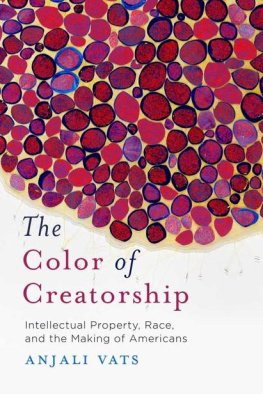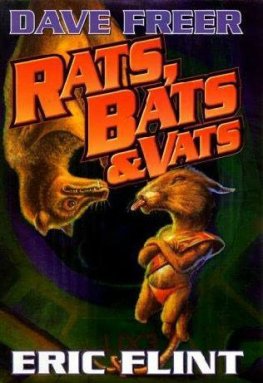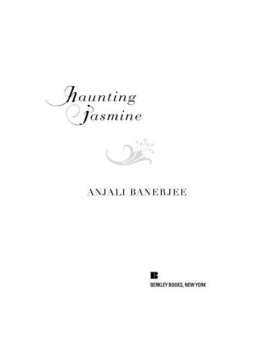Anjali Vats - The Color of Creatorship
Here you can read online Anjali Vats - The Color of Creatorship full text of the book (entire story) in english for free. Download pdf and epub, get meaning, cover and reviews about this ebook. year: 2020, publisher: Stanford University Press, genre: Politics. Description of the work, (preface) as well as reviews are available. Best literature library LitArk.com created for fans of good reading and offers a wide selection of genres:
Romance novel
Science fiction
Adventure
Detective
Science
History
Home and family
Prose
Art
Politics
Computer
Non-fiction
Religion
Business
Children
Humor
Choose a favorite category and find really read worthwhile books. Enjoy immersion in the world of imagination, feel the emotions of the characters or learn something new for yourself, make an fascinating discovery.
- Book:The Color of Creatorship
- Author:
- Publisher:Stanford University Press
- Genre:
- Year:2020
- Rating:4 / 5
- Favourites:Add to favourites
- Your mark:
- 80
- 1
- 2
- 3
- 4
- 5
The Color of Creatorship: summary, description and annotation
We offer to read an annotation, description, summary or preface (depends on what the author of the book "The Color of Creatorship" wrote himself). If you haven't found the necessary information about the book — write in the comments, we will try to find it.
The Color of Creatorship — read online for free the complete book (whole text) full work
Below is the text of the book, divided by pages. System saving the place of the last page read, allows you to conveniently read the book "The Color of Creatorship" online for free, without having to search again every time where you left off. Put a bookmark, and you can go to the page where you finished reading at any time.
Font size:
Interval:
Bookmark:
THE COLOR OF CREATORSHIP
Intellectual Property, Race, and the Making of Americans
Anjali Vats
STANFORD UNIVERSITY PRESS
STANFORD, CALIFORNIA
STANFORD UNIVERSITY PRESS
Stanford, California
2020 by the Board of Trustees of the Leland Stanford Junior University.
All rights reserved.
No part of this book may be reproduced or transmitted in any form or by any means, electronic or mechanical, including photocopying and recording, or in any information storage or retrieval system without the prior written permission of Stanford University Press.
Printed in the United States of America on acid-free, archival-quality paper
Library of Congress Cataloging-in-Publication Data
Names: Vats, Anjali, author.
Title: The color of creatorship : intellectual property, race, and the making of Americans / Anjali Vats.
Description: Stanford, California : Stanford University Press, 2020. | Includes bibliographical references and index.
Identifiers: LCCN 2019040803 (print) | LCCN 2019040804 (ebook) | ISBN 9781503603301 (cloth) | ISBN 9781503610958 (paperback) | ISBN 9781503610965 (ebook)
Subjects: LCSH: Intellectual propertySocial aspectsUnited States. | Race discriminationLaw and legislationUnited States.
Classification: LCC KF2979 .V38 2020 (print) | LCC KF2979 (ebook) | DDC 346.73048089dc23
LC record available at https://lccn.loc.gov/2019040803
LC ebook record available at https://lccn.loc.gov/2019040804
Cover art: Nancy Y. Kim. Bite of the Medusa (detail), 2018. Acrylic Paint, Paper Cells, and Thread Embedded in Acrylic Paint Skin, T-Pins, 6262 in.
Designed by Kevin Barrett Kane
Typeset at Stanford University Press in 10/14 Galliard Pro
For Jerrell Maurice Braden (19802012)
hope you enjoy the spelling, i actually
paid attention, sort of this time.
TABLE OF CONTENTS
ACKNOWLEDGMENTS
Writing a book is a process, one that is often lonely, frustrating, fraught, and anxiety-producing. However, it is also a process that provides fertile ground for connection, collaboration, and joy. I am thankful that my experience has been more of the latter than the former, involving more personal and professional growth than I ever imagined possible.
I began this project more than a decade ago, though not in this form. My first engagement with intellectual property law came in 2004, during my second year of law school. After years of working on issues of race and gender, I found the thought of engaging with a body of law that did not seem to me at the time to interface with social justice to be an intriguing one. It was not until much later, after I had completed my LLM at the University of Washington and clerkship at the Supreme Court of Nevada that I seriously contemplated the potential for critical race engagement with intellectual property law.
By my first year of graduate school, in 2009, I had begun to think critically about representations of infringement, layering my studies of race and rhetoric atop those of law. In the intervening decade, this book came together as a project about the racial histories of intellectual properties, as well as the insights that Critical Race Theory could bring to even the most progressive understandings of copyright, patents, and trademarks. In short, while I did not know this book would be the endgame when I started the project, I am pleased that my path has brought me here. A great many people across periods of my life, academic disciplines, and geographic spaces have inspired, supported, mentored, and befriended me over the years. As I am told happens with first books, this project is a record of my journey with them as much as it is the product of my research and writing.
At Boston College, I have developed a network of wonderful and supportive colleagues and friends. In the Communication Department, thank you to Ann Marie Barry, Marcus Breen, Christine Caswell, Lisa Cuklanz, Leslie Douglas, Ashley Duggan, Ali Erol, Don Fishman, Kristin Hartnett, Lindsey Hogan, Brett Ingram, Ernesto Livon-Grosman, Kristin Peterson, Rita Rosenthal, Mike Serazio, Matt Sienkewicz, Tony Tran, and Celeste Wells. It continues to be a pleasure to work with all of you. I am particularly indebted to Lisa for being a tireless and dedicated advocate, mentor, and cheerleader to me in her role as department chair.
To my colleagues in African and African Diaspora StudiesAmey Victoria Adkins-Jones, M. Shawn Copeland, Allison Curseen, Kyrah Malika Daniels, Rhonda Frederick, Jonathan Howard, Rgine Jean-Charles, C. Shawn McGuffey, Richard Paul, and Martin Summersyour brilliance, fierceness, warmth, humor, and undying commitment to social justice keep me going even in the toughest moments.
In Asian American Studies, I am grateful to Arissa Oh and Min Hyoung Song for building spaces to do the work that we do. In the law school, my thanks to Renee Jones, Vincent Rougeau, and Fred Yen for your enthusiastic commitment to this and other critical race studies projects that I have undertaken; your support has been integral to the completion of this project. Finally, to Provost David Quigley and Dean Greg KalscheurI cannot thank you enough for providing me with the space and latitude to take a year of research leave so that I could concentrate on completing this book; it is markedly better because I had that time.
One of the great pleasures and privileges that writing this book has afforded me is connecting with the Microsoft Research New England's intellectually vibrant Social Media Collective. Thank you to Nancy Baym, Tarleton Gillespie, and Mary Gray for embracing me as part of your community of scholars. I am also grateful to the many interlocutors with whom I had the opportunity to connect at SMC, including Kelly Buckley, Robyn Caplan, Michaelanne Dye, Dan Greene, Sarah Hamid, Elena Maris, Dylan Mulvin, Chris Persaud, Bill Thies, and Penny Trieu.
Nearly a year of research leave spent at the University of California, Davis School of Law was also of considerable importance to the development of this project. My appreciation to Mario Biagioli, Anupam Chander, and Madhavi Sunder for inviting me to join King Halls scholarly community. Thank you, as well, to Karima Bennoune, Jack Chin, Angela Harris, Jasmine Harris, Lisa Ikemoto, Rana Jafeel, Kevin Johnson, Peter Lee, and Donna Shetowsky for being generous scholars and fast friends. I also owe a debt of gratitude to the American Association for University Women for awarding me the postdoctoral fellowship that allowed me to spend immeasurably productive time in Davis finishing this book manuscript.
I was lucky enough to get a dream job at Indiana University the year after I graduated. The faculty I met in Bloomingtonincluding Carolyn Calloway-Thomas, Steph deBoer, Liz Elcessor, Laura Foster, Ilana Gershon, Jane Goodman, Joan Hawkins, Mark Janis, Barb Klinger, John Lucaites, Radhika Parameswaran, Phaedra Pezzullo, Ryan Powell, Ted Striphas, Robert Terrill, and Greg Wallerprovided guidance and friendship that have lasted far beyond my brief stopover in Indiana.
Much of this book was written in the Pacific Northwest, a place that never fails to nourish my soul. My gratitude to my PNW friends, colleagues, and mentors from across institutions who made and continue to make Seattle and Tacoma a scholarly home away from home: Herb Blau, Derek Buescher, Leah Ceccarelli, Maggie Chon, Lisa Coutu, David Domke, Justin Eckstein, Peter Ehrenhaus, Dexter Gordon, Christine Harold, Mako Hill, Jim Jasinski, Ralina Joseph, LeiLani Nishime, Sean OConnor, Sue Owen, Zahr Said, Kathy Woodward, and Amy Young.
I owe special thanks to a few brilliant mentors, who continue to teach me to thrive in the academy and in life. Ralina and LeiLani, you are the best mentors, comrades, and friends that I can imagine. Dexter, you provided revelatory guidance when I didnt even know I needed it. And Maggie, your intellectual prowess coupled with gentleness of spirit have nourished my soul. Your conceptions of community and solidarity have inspired me as a young scholar. It is a privilege to do the racial justice work that each of you teaches and models on the West Coast here on the East Coast.
Next pageFont size:
Interval:
Bookmark:
Similar books «The Color of Creatorship»
Look at similar books to The Color of Creatorship. We have selected literature similar in name and meaning in the hope of providing readers with more options to find new, interesting, not yet read works.
Discussion, reviews of the book The Color of Creatorship and just readers' own opinions. Leave your comments, write what you think about the work, its meaning or the main characters. Specify what exactly you liked and what you didn't like, and why you think so.













